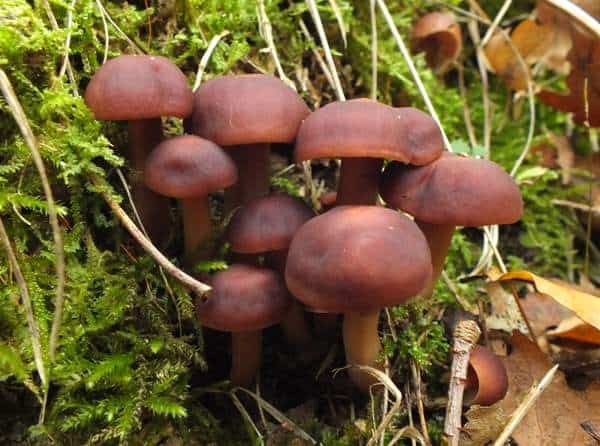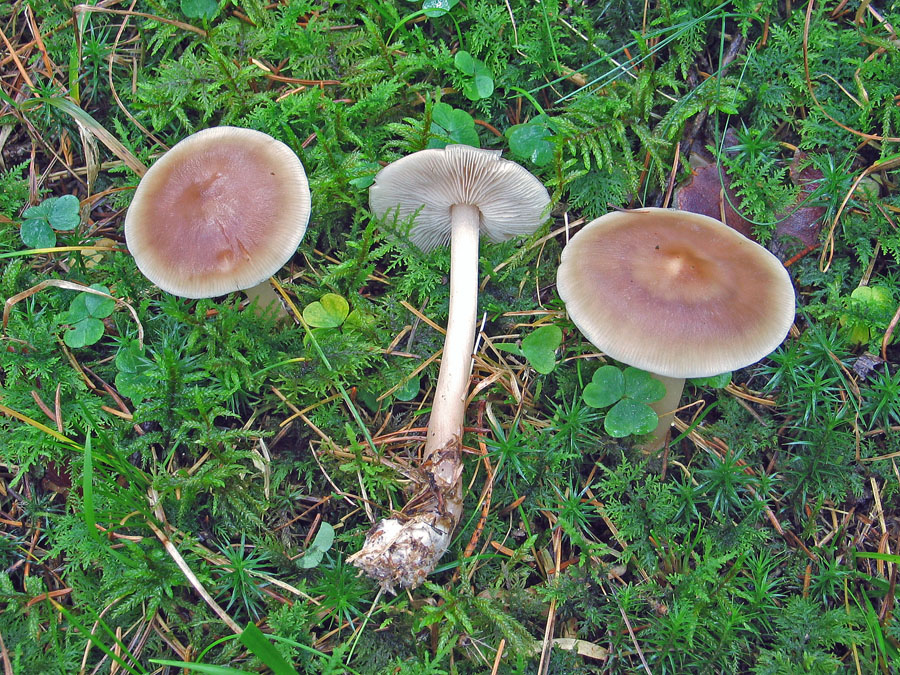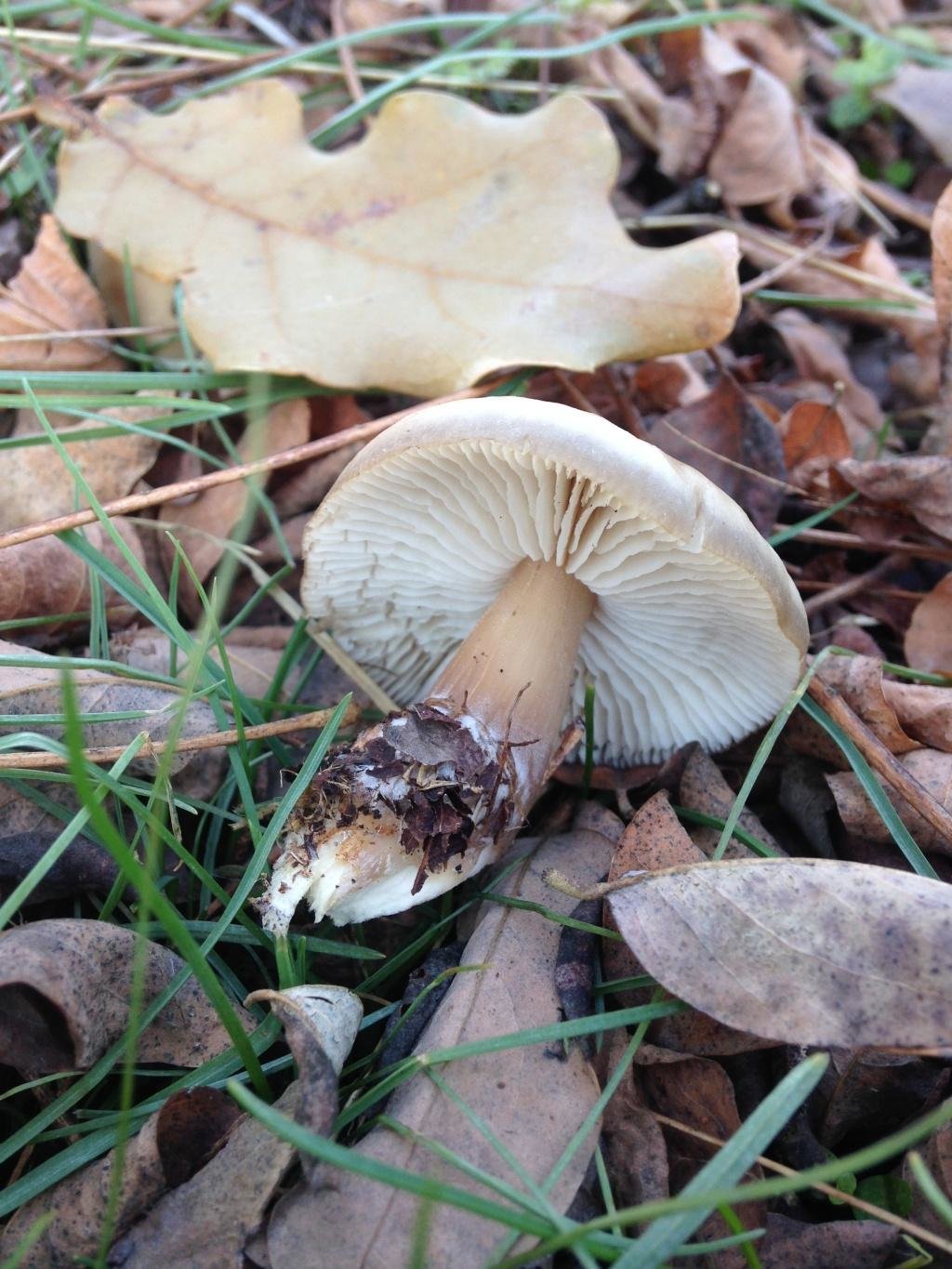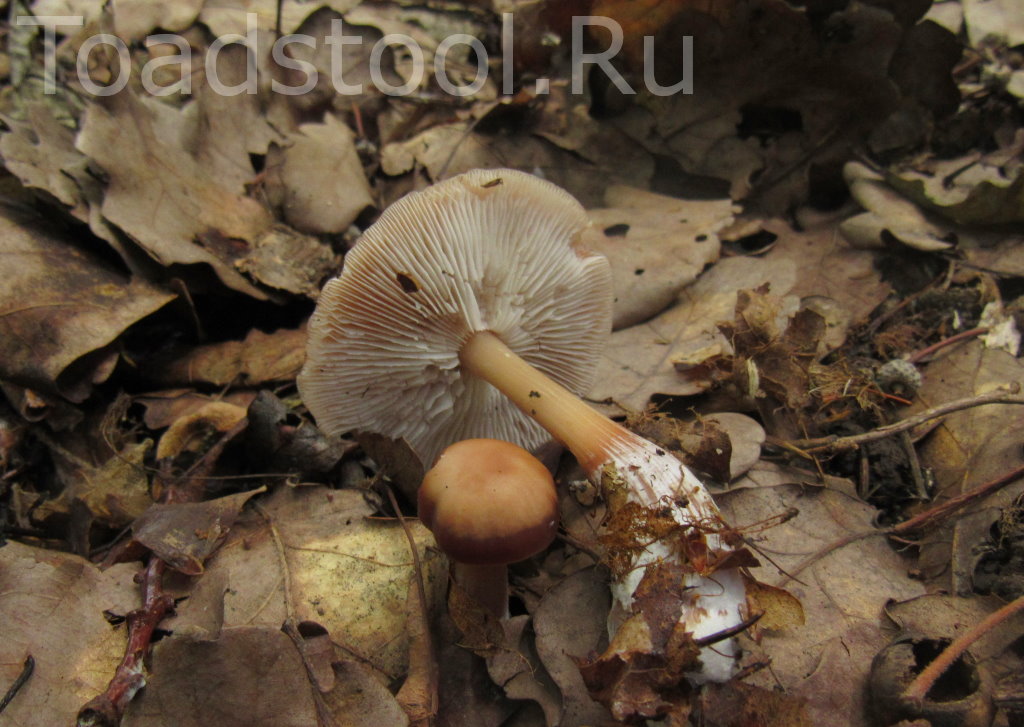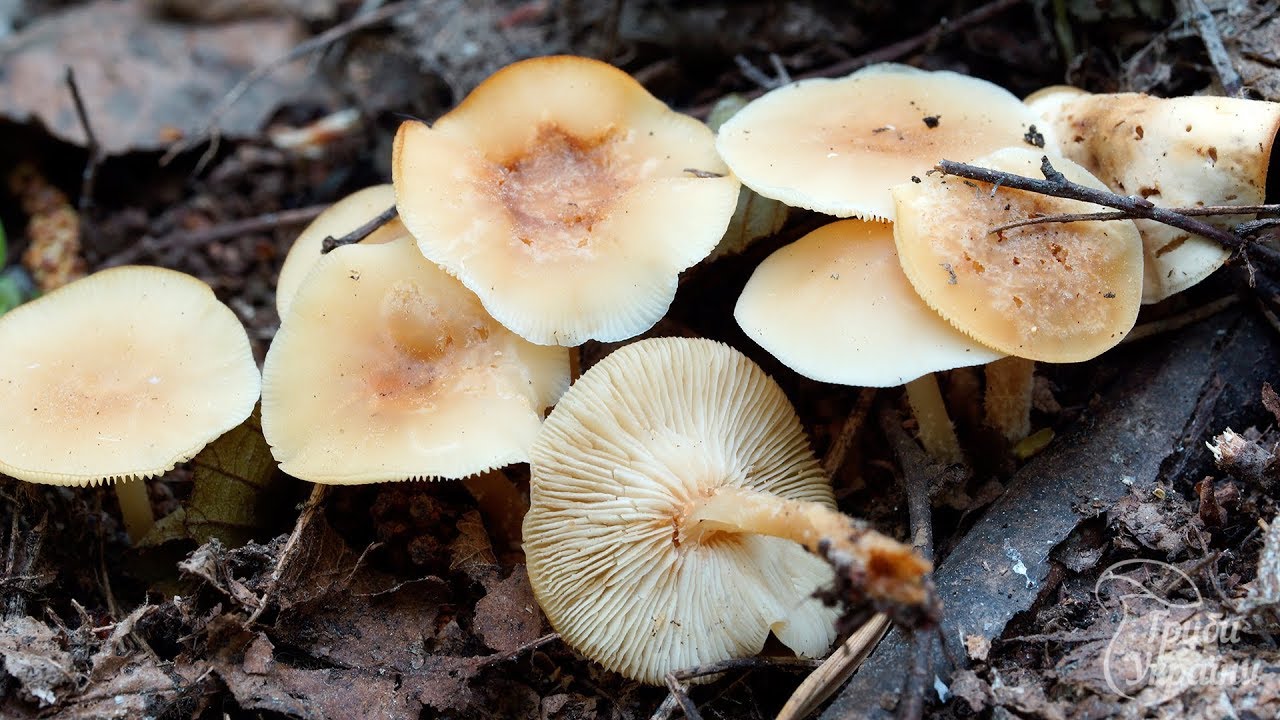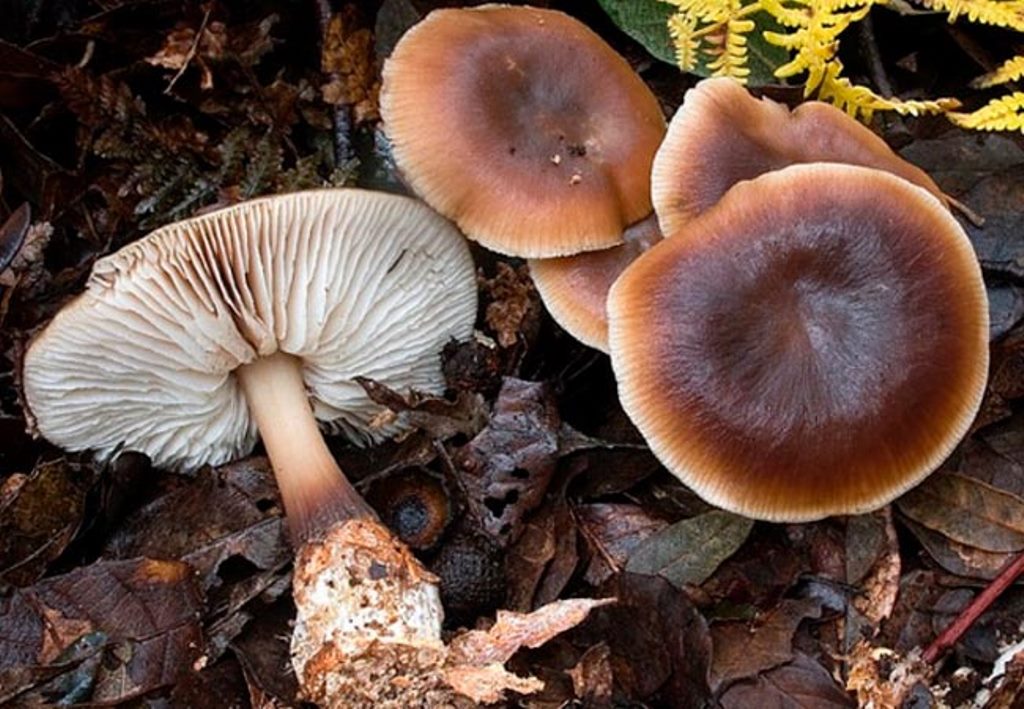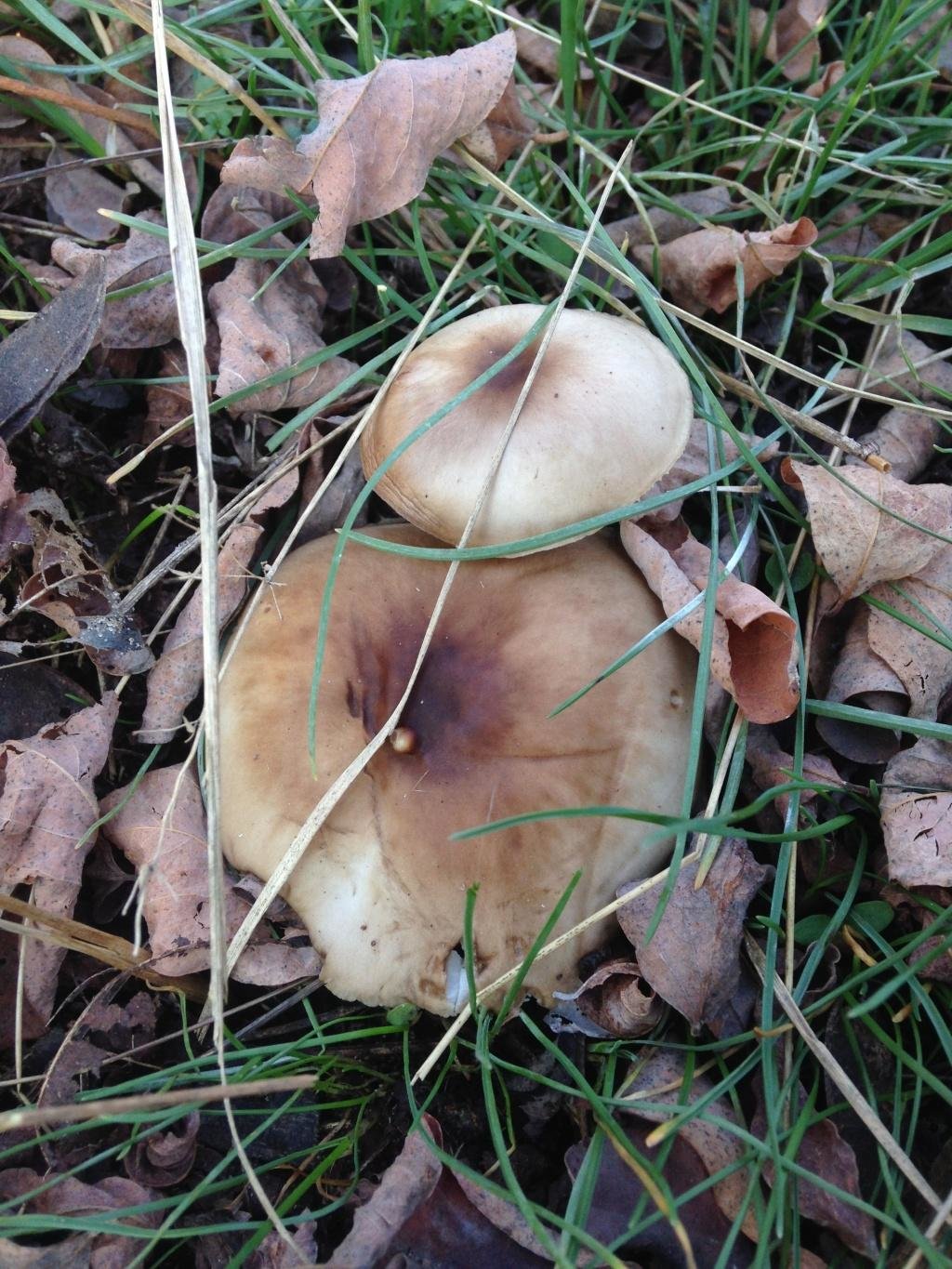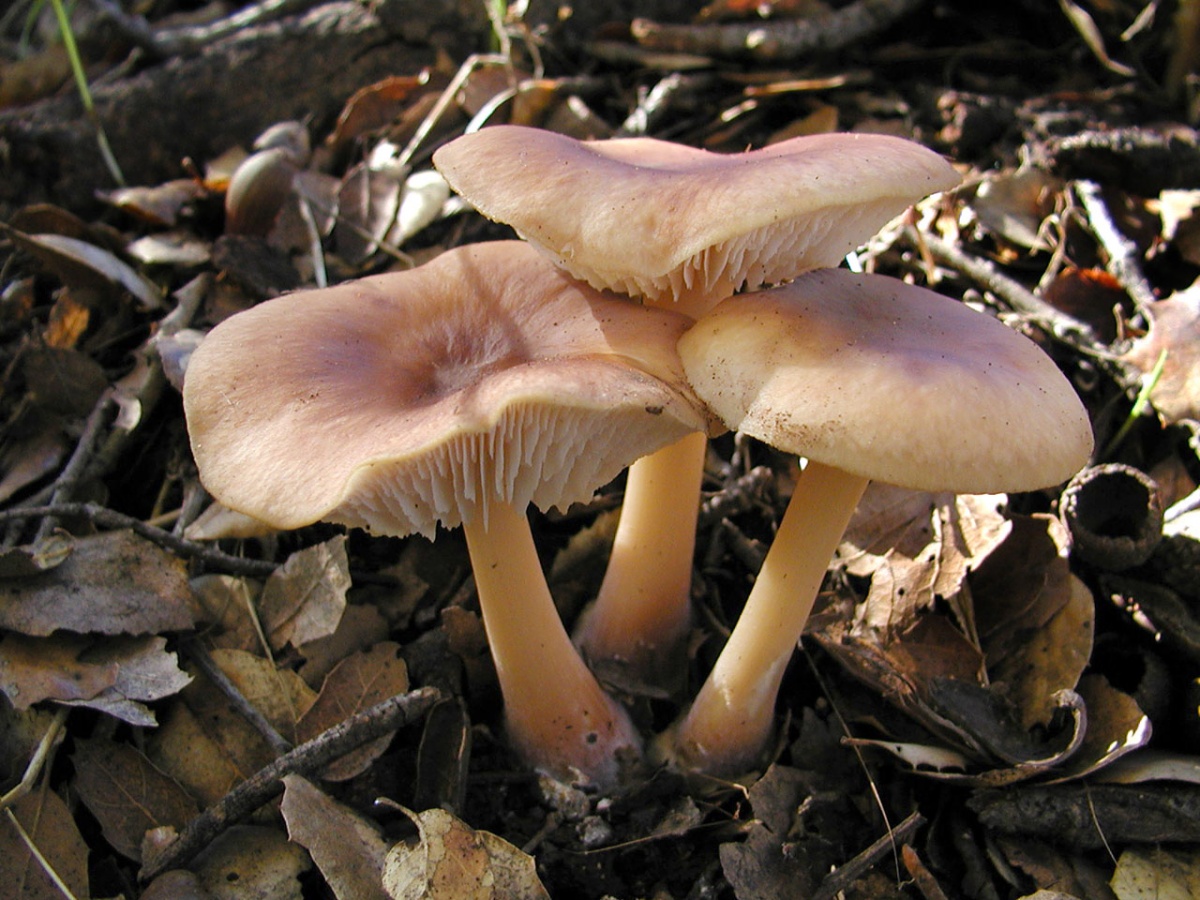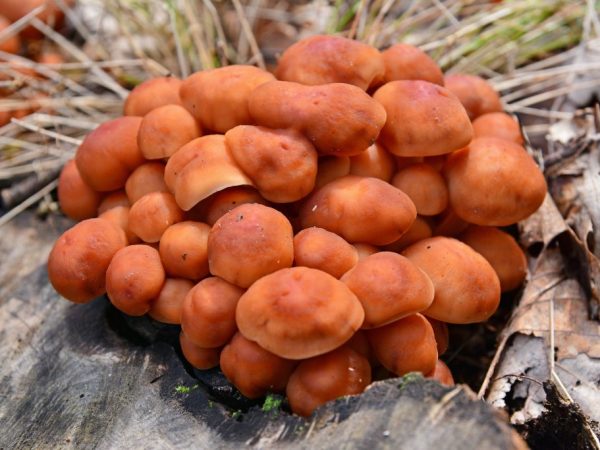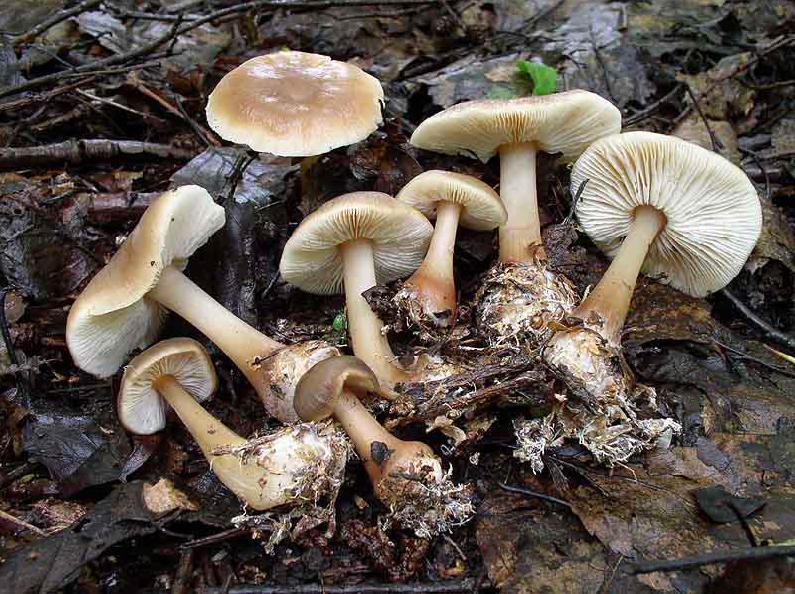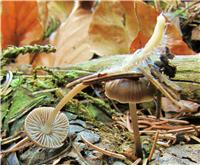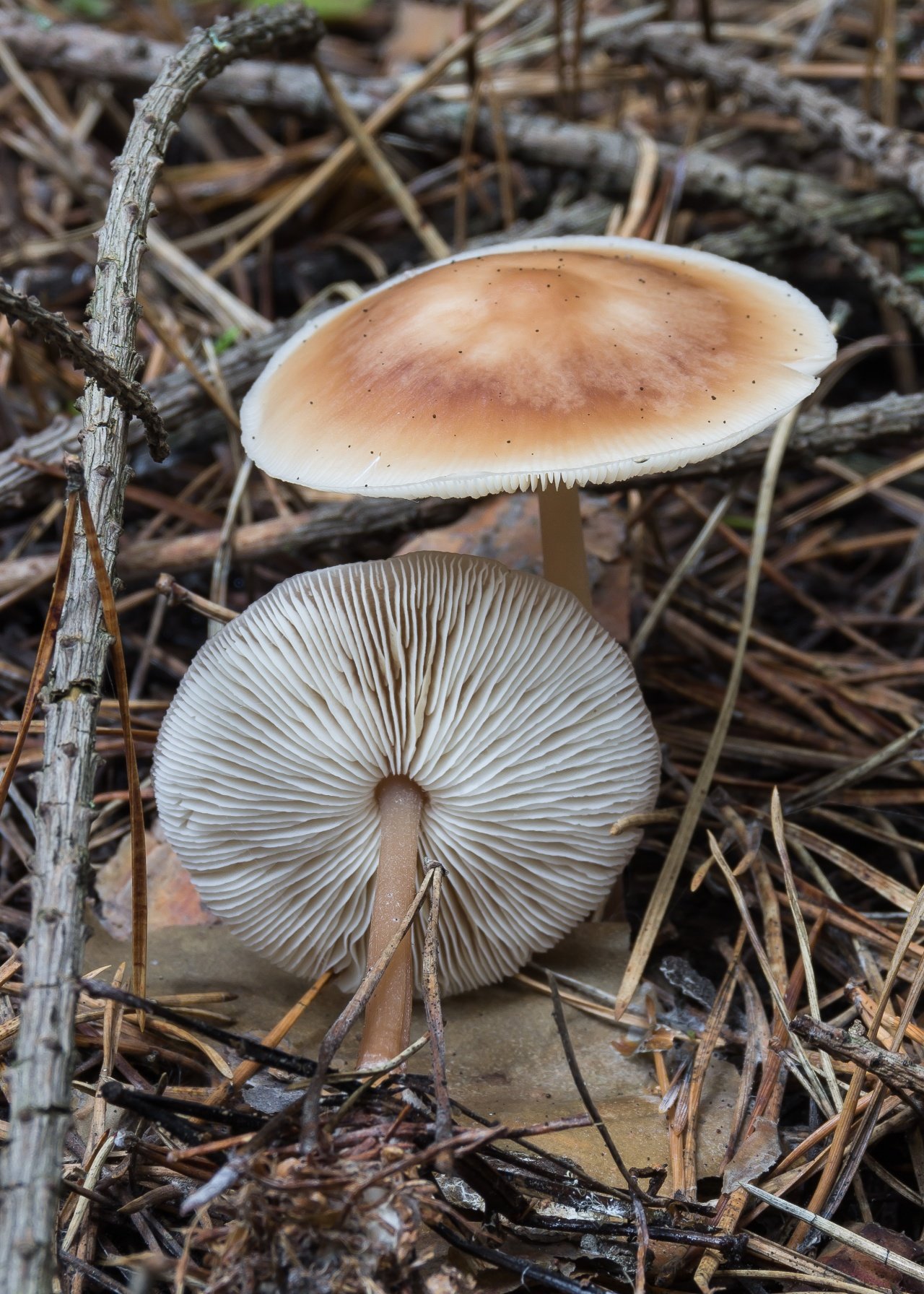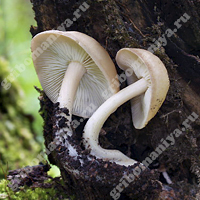Characteristics of the forest-loving colibia
Young colibia mushrooms have a cap that looks like a sphere. As the mushroom develops, its cap takes on a spread, flat shape with transparent margins. The diameter of the mushroom cap reaches about 2-6 cm. Young colibia fungi have some similarity with apples that fell on fallen leaves in the forest.
Nature has endowed this mushroom with a special reddish-red hue. In the center of the cap, the color of the mushroom becomes darker, and down to the edge, the color becomes lighter. In old mushrooms, the color of the cap becomes pale ocher. But the young representatives of this family have a translucent color. The higher the humidity in the forest, the more pronounced and distinct the color of the mushroom becomes. With the onset of the dry season, colibia takes on an inconspicuous appearance and becomes inconspicuous.
The core of the mushroom has brown, light yellow or sometimes white flesh. The color of the pulp directly depends on the conditions and environment in which the mushroom matures. If you look through the thin and transparent edges of the cap, you can see the plates that are weakly attached to the base of the mushroom. The older the mushroom ripens, the more it will become covered with reddish spots that appear on the inside of the fruit. The transparent and thin edges start to tear.
The mushroom leg has a thin base, it is hollow inside and twists slightly along its length, at the end it thickens a little. The structure of the stem of the fungus has a fibrous and cartilaginous surface. The cap and leg are the same color. The mushroom leg can be up to 2 or 6 cm in length.
autumn honey fungus - description of where they grow, the toxicity of the mushroom
Collybia chestnut, or oily (Collybia butyracea)
Habitat: mixed and coniferous forests, on forest floor, on decaying wood, usually grows in groups.
SEASON: May - October.
In the middle and end of May, the first types of collibies appear. These include, first of all, chestnut or oily colibs. These cute little mushrooms attract with their spectacular appearance, although they are small in size. Although they are edible, they are not harvested due to their small size and the lowest, fourth category for food properties.
At this time, many singing birds can be observed in the forest, for example, buntings, which climb onto the upper branches and sing, sing, sing.
The cap has a diameter of 3-8 cm, at first hemispherical, later convex with a round tubercle and then prostrate with a flat tubercle and raised or curved edges. A distinctive feature of the species is the chestnut brown color of the cap with a flat tubercle of a darker brown color and light, cream or light brown edges.
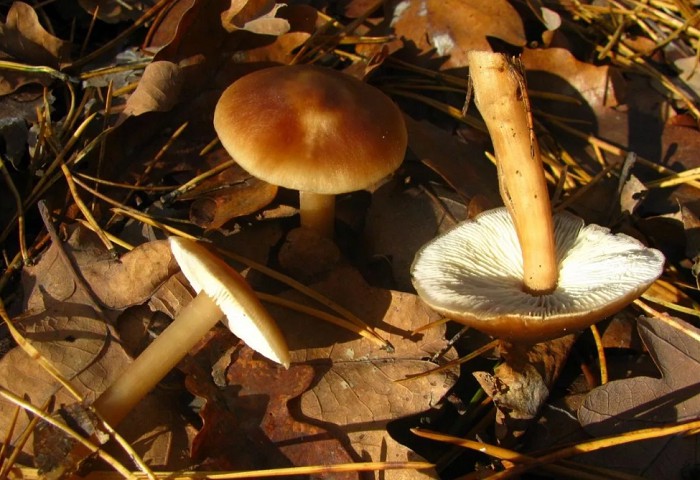
Stem 4-9 cm tall, thin, 2-8 mm thick, cylindrical, smooth, creamy at first, later fawn-brown. The base of the leg is thickened.
The pulp is watery, thin, soft, whitish or yellowish, odorless at first, later with a faint moldy odor.
The plates are creamy or yellowish, notched-adherent. Short free plates are located between the adherent plates.
Variability: The color of the cap is variable depending on the maturity of the fungus, the month and the humidity of the season. The color can be chestnut brown, especially in early summer, red-brown with a brown tint, brown-brown with a dark middle, gray-brown with an olive tint, lilac brown. In the dry season, the cap fades to light shades of yellow, cream and light brown.
Similar species. Collybia chestnut in shape and size is similar to the edible wood-loving collybia (Collybia dryophila), which differs in that it has a much lighter cap.
Edible: edible, but requires pre-cooking in 2 waters to eliminate mold odor.
Edible, 4th category.
Colibia Azema (Gymnopus Azema): photo and description
| Name: | Collibia Azema |
| Latin name: | Rhodocollybia Butyracea |
| Type of: | Edible |
| Synonyms: | Collybia Butyracea var Asema, Rhodocollybia Butyracea var Asema |
| Systematics: |
|
Edible lamellar mushroom of the Omphalotoceae family, belongs to the 3rd group in terms of nutritional value. Colibia Azema is known by several names: Gymnopus Azema, Rhodocollybia Butyracea, Rhodocollybia Butyracea var. Asema.

Description of the Azema colibia
Gymnopus Azema is a saprophytic species that grows on decayed wood residues or a broken leaf layer, on moist acidic soils. The color of the fruit body is light gray with a greenish tint, in an open sunny area it is silvery-ash, less often light brown specimens are found.
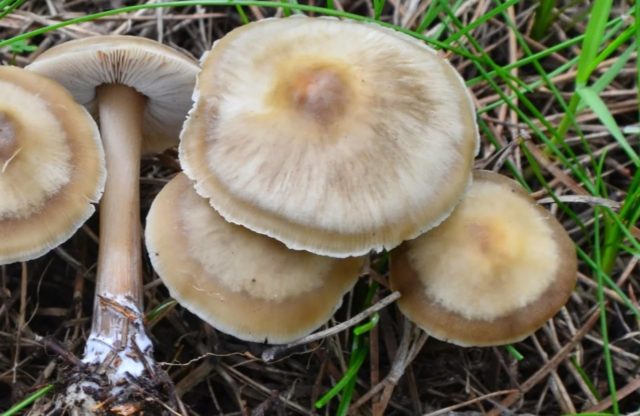
Description of the hat
The hat does not have one tone, the convex central part is darker, often with an ocher tint. A hygrophane strip in the form of a circle is determined along the edge; in a humid environment it is more pronounced, in a dry environment it is weaker. May be completely absent.

Colibia cap characteristic:
- at the beginning of growth, the shape is rounded with concave edges;
- in an older mushroom, it is prostrate, uneven edges are raised upward, diameter is 4-6 cm;
- the protective film is slippery, oily, regardless of air humidity;
- plates are light with a slight gray tint, of two types. Large ones are often located, firmly fixed in the lower part. Small ones occupy 1/3 of the length, are located along the edge, in adult specimens they protrude beyond the boundaries of the fruiting body;
- spore powder is grayish.
White pulp is dense, thin, fragile. With a pleasant smell and sweetish taste.
Leg description
The leg of the Azema colibia grows in length up to 6-8 cm, diameter - 7 mm. The color is monochromatic, gray-yellow with a slight brown tint.
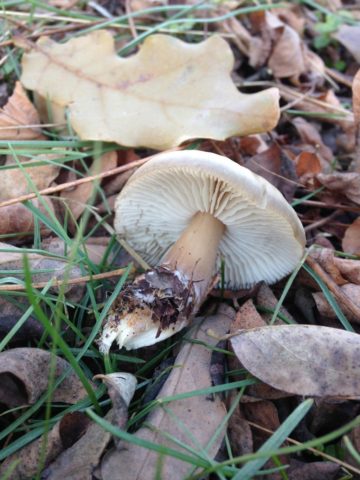
The color is always the same as the surface of the cap. The leg is wider at the base than at the top. The structure is fibrous, rigid, hollow.
Is the mushroom edible or not
This type of colibia belongs to the group of edible mushrooms. Suitable for any kind of processing. The pulp is dense, with a pleasant taste, does not require special processing. Colibia is used for salting, pickling. Mushrooms are fried, included in assorted vegetables, and first courses are prepared.
Where to look for the Azem collision
The species is common in the southern regions and the temperate climatic zone. Grows in mixed forests, deciduous and coniferous. The main condition is moist acidic soil.
How to collect Azema collibium
The species belongs to autumn mushrooms, the fruiting time is from August to the first half of October. In warm climates, the last specimens can be found in early November. The main growth begins after rains, when the temperature drops to +170 C. It grows under trees on a moss or coniferous pillow, the remains of rotten wood, stumps and bark, branches or rotten leaves.
Doubles and their differences
Oily colibia are related to similar species. A closely related fungus is difficult to distinguish from Rhodocollybia Butyracea var. Asema.
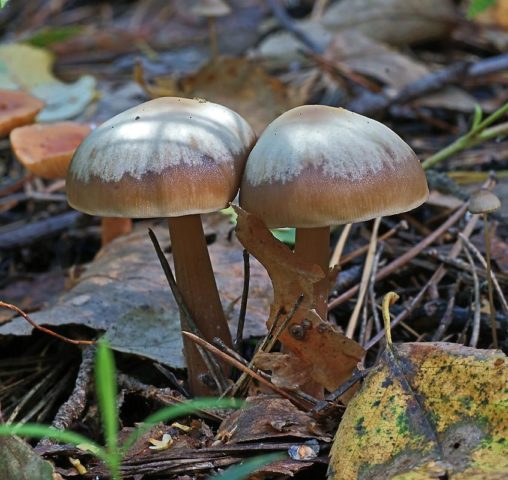
The fruiting time of the twin is the same, the distribution area is also the same. The species is classified as conditionally edible. Upon closer examination, it is clear that the twin is larger, its fruit body is darker.
Conclusion
Colibia Azema is an edible saprophytic mushroom. Fruiting in autumn, distributed from the south to European regions. It grows in various types of forests on wood debris and decayed leaf litter. The fruit body is versatile in processing.
Collibia oil - Rhodocollybia butyracea
Written by Nikolay Budnik and Elena Meck.
Colibia oily or oily is a late autumn mushroom. It is also called oily money. Why the money - we do not know! Some specimens are found already in August, but the bulk of the mushrooms appear at the end of September. This mushroom does not have a pronounced taste and smell, but it grows massively when there are almost no other mushrooms.So you can safely collect and fry them without prior boiling. We practically do not take this mushroom - there are enough others.
Colibia butterfish most often grows in fairly dry coniferous forests. Mushrooms begin to grow en masse at the end of September and disappear under the snow. Colibia is a small, thin-fleshy mushroom: up to 7-8 cm in diameter.

1. On Ulom Zhelezniy, oily colliery is a fairly common mushroom.

2. Since it grows right up to the snow, it can be harvested when there are very few other mushrooms.

3. Usually fungi are not found one at a time.

4. They grow up in families, groups.

5. . and this compensates for their small size.

6. Oil colibia can most often be found in a dry pine forest.

7.. among the fallen needles.

8. It also grows under the trees.

9. This is a very small mushroom.

10. Rare specimens reach this size.

11. And most of them are small in size.

12. This is the common size of mushrooms.

13. The hat is smooth, first convex, then extended.

14. It almost always has a tubercle in the center.

15. It can be colored in different ways - brown, chestnut, burgundy-brown, red.

16. The edge of the cap is usually light, even white, and the middle is dark.

17. Plates are frequent and thin.

18. They are always white - this is a characteristic feature of collebration.

19. Only in old age can they darken a little.

20. This is how the plates are attached to the leg.

21. The leg is cartilaginous and stiff.

22. Inside, it is hollow.

23. The leg is long, thin and straight.

24.. but more often the leg expands evenly downward.

25. The color of the leg is much darker than the plates - like a hat.

26. Under the cap, the leg is flattened, not cylindrical.

27. Below, it is often covered with a light fluffy coating.

28. The flesh of the mushroom is rather thin, watery.

29. It is white or brownish, with a faint mushroom odor.
Definitioner
- Basidia (Basidia)
-
Lat. Basidia. A specialized structure of sexual reproduction in fungi, inherent only in Basidiomycetes. Basidia are terminal (end) elements of hyphae of various shapes and sizes, on which spores develop exogenously (outside).
Basidia are diverse in structure and method of attachment to hyphae.
According to the position relative to the axis of the hypha, to which they are attached, three types of basidia are distinguished:
Apical basidia are formed from the terminal cell of the hypha and are located parallel to its axis.
Pleurobasidia are formed from lateral processes and are located perpendicular to the axis of the hypha, which continues to grow and can form new processes with basidia.
Subasidia are formed from a lateral process, turned perpendicular to the axis of the hypha, which, after the formation of one basidium, stops its growth.
Based on morphology:
Holobasidia - unicellular basidia, not divided by septa (see Fig. A, D.).
Phragmobasidia are divided by transverse or vertical septa, usually into four cells (see Fig. B, C).
By type of development:
Heterobasidia consists of two parts - hypobasidia and epibasidia developing from it, with or without partitions (see Fig. C, B) (see Fig. D).
Homobasidia is not divided into hypo- and epibasidia and in all cases is considered holobasidia (Fig. A).
Basidia is the place of karyogamy, meiosis and the formation of basidiospores. Homobasidia, as a rule, is not functionally divided, and meiosis follows karyogamy in it. However, basidia can be divided into probasidia - the site of karyogamy and metabasidia - the site of meiosis. Probasidium is often a dormant spore, for example in rust fungi. In such cases, probazidia grows with metabasidia, in which meiosis occurs and on which basidiospores are formed (see Fig. E).

See Karyogamy, Meiosis, Gifa.
- Pileipellis
-
Lat. Pileipellis, skin - differentiated surface layer of the cap of agaricoid basidiomycetes. The structure of the skin in most cases differs from the inner flesh of the cap and may have a different structure.The structural features of pileipellis are often used as diagnostic features in descriptions of fungi species.
According to their structure, they are divided into four main types: cutis, trichoderma, hymeniderma and epithelium.
See Agaricoid fungi, Basidiomycete, Cutis, Trichoderma, Gimeniderm, Epithelium.
- Cutis
-
The type of cap skin, consists of creeping non-gelatinized hyphae located parallel to the surface. The surface of the cap looks smooth.
Lat. Cutis.
See Gifa.
Collibia Azema
Collybia asema - Collybia asema
In another way, this fungus, unpopular among lovers of quiet hunting, is called the Azema Rodocollibia or Azema Gymnopus.
Description
Mushroom cap
The hats of the young Rhodocolibia Azema have the shape of a mild wide cone with a mound in the middle and tucked edges. In the future, they gradually unfold, the edges become uneven, cracked and often rise upward. The center mounds remain in place.
The diameter of the hats varies from 30 to 60 mm.
The hat is covered with an oily glossy skin that turns yellow-brown or ocher-brown, turning into brown-gray or dark brown with age. The edges always look lighter, and the plates shine through them. The mound has a darker color.
Gymnopus Azema is filled with white - creamy friable pulp.
The hat bottom is filled with whitish thin frequent plates, usually not growing to the legs.
Colibia Azema reproduces by colorless smooth ellipsoidal spores contained in a white spore powder.
Stipe
The legs of this type of collibia look strong and stocky, in the form of cylinders, thinning up and widening downward. Their thickness is 4-8 mm, height - 50-70 mm.
In young mushrooms, the leg is plump, in adults it is more slender. It has a grayish yellow or ocher color. The base is covered with white mycelium.
The legs are filled with white, fibrous, loose flesh.
Collybia asema - Collybia asema
Growing places
Rodocollibia Azema prefers the acidic soil of conifers; it also grows in deciduous and mixed forests. Fruiting is usually group, but there are also single specimens. The mushroom gives abundant harvests from the second half of August to mid-September.
Although the pulp of the mushroom does not have a rich taste and aroma, it is classified as an edible mushroom that can be eaten in any form.
Les-loving colliery (Gymnopus dryophilus)
- Other names for the mushroom:
- Spring honey
- Collybia is dubious
- Colibia Dubravnaya
- Regular money
- Wood-loving money
Synonyms:
Hat:
Diameter 2-6 cm, in youth hemispherical, with age gradually opens up to prostrate; plates often shine through the edges of the cap. The fabric is hygrophilous, the color changes depending on humidity: the color of the central zone varies from brown to light red, the outer zone is lighter (to waxy-whitish). The flesh of the cap is thin, whitish; the smell is weak, the taste is difficult to distinguish.
Plates:
Frequent, poorly adherent, thin, white or yellowish.
Spore powder:
White.
Leg:
Hollow, fibrous-cartilaginous, 2-6 cm in height, rather thin (the mushroom, as a rule, looks proportional), often pubescent at the base, with a cylindrical, slightly widening at the bottom; the color of the leg more or less corresponds to the color of the central part of the cap.
Spreading:
Wood-loving collibia grows from mid-May to late autumn in forests of various types - both on the litter and on the decaying remains of trees. In June-July, it is found in large numbers.
Similar species:
Mushroom colibia les-loving can be confused with meadow honey (Marasmius oreades) - much more frequent plates can serve as distinctive signs of coliby; in addition, there are several closely related species of colibia, which are relatively rare and, without a microscope, are completely indistinguishable from Collybia dryophila.Finally, this mushroom strikingly differs from light specimens of chestnut colibia (Rhodocollybia butyracea) by a cylindrical, not very thickened stem.
Edibility:
Various sources agree that the forest-loving Collibia mushroom is, in general, edible, but it makes no sense: there is little meat, there is no taste. However, no one forbids trying.
Notes:
The pseudo-popular name "money", supposedly referring to all small collisions, does not justify itself at all. For mushroom pickers, colibies are a kind of "backdrop" against which mushroom comedies and dramas are played; small colibies are an element of forest decoration, the same as last year's cones and night blindness flowers. What kind of "money" is there if you can't even count them!
However, some mushroom pickers still pay attention to the wood-loving colibia, strangely calling it "forest meadow honey." At the same time, explanations always follow in the sense that it makes no sense to collect forest meadow mushrooms, because there is neither taste nor smell in them
So, something has grown.
What is the value of "money" - the chestnut Colibia mushroom?

Description
Lat. Rhodocollybia butyracea, Collybia butyracea. Other names - Rhodocolibia oily, Colibia oily, Colibia chestnut, Oily money.
This is a genus of caps, late ripening, conditionally edible, colibioid fungi of the Ryadovkov family, which are often called "money" for their external resemblance to small coins.
Hat
A young mushroom has a hemispherical cap. Over time, it becomes more convex, and later acquires a prostrate, slightly depressed appearance with upward curved edges. Its diameter is 2–12 centimeters. Some specimens have a small tubercle in the center.
Colibia's cap is oil hygrohan, that is, it is capable of changing its appearance depending not only on age, but also on the level of humidity in the growing area. In rainy weather, its surface becomes oily.
The color of the cap can be light brown, reddish, burgundy, chestnut, brown. The edges are painted in lighter colors.
Hymenophore

The lower part of the cap, or hymenophore, consists of a large number of frequently located plates. They are located freely or can be tightly adhered to the stem. There are shortened intermediate plates between the large plates.
A characteristic feature of colibia is the white color of the hymenophore. In the process of maturation, it acquires a pink tint, and with age, the plates become darker.
Spores are smooth, slightly elongated and elliptical. Their powder is colored white, pale yellow or pinkish.
Pulp
Collibia is a thin-fleshy mushroom. The pulp is watery, white or light brown in color. Under the skin, it has a rich brown color.
Leg
The leg is even, cartilaginous, rigid, hollow inside. Its length ranges from 2 to 10 cm, in girth it can reach 1 cm. In the upper part, under the cap, it is slightly flattened, and in the lower part it has a slight thickening, covered with a white felt coating.
Time and place of fruiting oil money
The fungus is quite rare. At the same time, it is well camouflaged near the bases of trees and is not always visible to mushroom pickers.
Rhodocollybia butyracea is a saprotroph that grows in coniferous and deciduous forests on dried wood, in grass, moss or leaf litter. Most often it can be found in the pine forest.
It grows from the beginning of summer until the first snow, when there are no other relatives. When collecting, the fruit body is cut off at the root, and this place is covered with earth or foliage.
False doubles
The main difference between money and related species, including inedible ones, is the oily cap. Interest for lovers of "quiet hunting" may be of such varieties:
- Collibia is spotted. It belongs to conditionally edible mushrooms and close relatives of butterflies. It has a conical or hemispherical cap with edges turned down. Its surface is white with brown-rusty spots, which serve as a distinctive feature.The pulp is elastic and very firm. The leg is slightly curved, painted white with small brown spots on the surface. It requires moist and acidic soil to grow. It is found in very large families.
The difference between different types of collisions can be seen in the photo.
Taste qualities of Colibia buttery
Colibia oil has a smack of sawdust, so it is rarely eaten, although it belongs to conditionally edible mushrooms. To get rid of the unpleasant taste, it is pre-boiled for 10-15 minutes. Only hats are used for cooking.
Cooking recipes

After collection, the colibia should be properly handled.
- To do this, pour it into a large container and fill it with cold, slightly salted water for 10 minutes. This procedure will quickly get rid of dirt, dirt, adhering leaves and insects.
- Then the mushrooms are washed and the caps are separated from the legs, since the oil legs of the money are hard and are not used for cooking.
- Clean fruit bodies are placed in a large saucepan, poured over with cold water and brought to a boil over high heat.
- Reducing the flame, cook for another 15 minutes, then drain and rinse with running water.
Boiled mushrooms can be used with onions, carrots, garlic, peppers and sour cream. Colibia goes well with stews, chicken and meat. It can also be pickled and salted.
Excerpt from Colibia oily
- You love him? “Yes,” Natasha whispered. - What are you crying about? I'm happy for you, ”said Princess Marya, forgiving these tears Natasha’s joy. - It won't be soon, someday. Think what happiness it is when I am his wife and you marry Nicolas. - Natasha, I asked you not to talk about it. Let's talk about you. They were silent. - Just why go to Petersburg! - Natasha suddenly said, and she herself hastily answered herself: - No, no, this is so necessary ... Yes, Marie? This is how it should be ... Seven years have passed since the 12th year. The agitated historic sea of Europe has settled on its shores. It seemed quiet; but the mysterious forces that move humanity (mysterious because the laws governing their movement are unknown to us) continued to operate. Despite the fact that the surface of the historical sea seemed motionless, humanity moved as continuously as the movement of time. Various groups of human bonds were formed, decomposed; the reasons for the formation and disintegration of states, the movement of peoples were prepared. The historic sea, not as before, was directed by gusts from one coast to another: it seethed in the depths. Historical figures, not as before, rushed in waves from one coast to another; now they seemed to be spinning in one place. Historical figures, formerly at the head of the troops reflecting the orders of wars, campaigns, battles, the movement of the masses, now reflected the seething movement by political and diplomatic considerations, laws, treatises ... Historians call this activity of historical figures a reaction. In describing the activities of these historical figures, who, in their opinion, were the cause of what they call a reaction, historians strongly condemn them. All famous people of that time, from Alexander and Napoleon to m me Stael, Photius, Schelling, Fichte, Chateaubriand, and others, pass before their strict judgment and are acquitted or condemned, depending on whether they contributed to progress or reaction.
Description of the Azema colibia
Colibia Azema may have an even cap or a cap with edges bent down, its shape depending on the age of the fruiting body. As the mushroom matures, the shape of the cap opens more and more. The surface of the cap is shiny, very oily. The hat is of medium size - about 6 centimeters in diameter.

There are white plates under the head. The leg is thickened, its lower part is especially massive. The length of the leg reaches 6 centimeters.
Where to look and when to collect the Azem collibium
These mushrooms are harvested from late summer to mid-autumn. Find them on acidic soils.They can be found in almost any forest.

